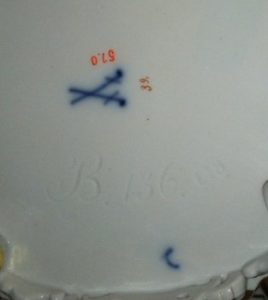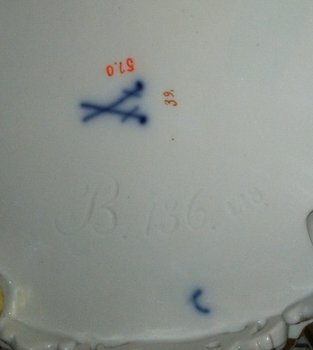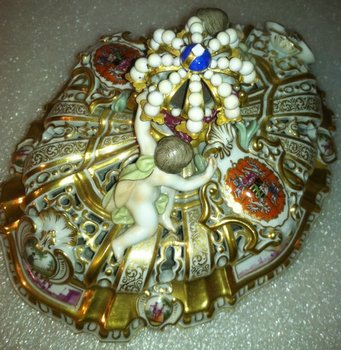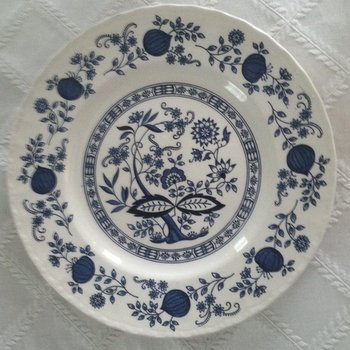
by Dr. Lori Verderame
Meissen hard paste porcelain was developed near Dresden, Germany in the 18th Century. Meissen porcelain is still made today as Staatliche Porzellan-Manufaktur Meissen GmbH. By 1720, the Meissen factory, based on Johann Friedrich Bottger’s method for producing hard paste porcelain, made some of the finest porcelain in the world.
Meissen mark

There were three major factories in the production of European porcelain in the 18th Century that remain at the top of the heap when it comes to the history of European porcelain and ceramics. There was French Sevres porcelain (mark: royal cipher with interlaced “L” letter forms) which is not to be confused with the very popular, hand painted Quimper pottery, German Meissen porcelain (mark: blue crossed swords), and Vienna porcelain of Austria (mark: blue Austrian shield or beehive form). When understanding pottery marks and learning how to decode pottery marks, these three porcelain production firms are very important to the history of the medium.
What to Look For
Unlike Staffordshire pottery from England or German-made Hummel figurines which feature genre scenes rather than high style subjects and imagery, Meissen porcelain is known for allegorical figures, figures in period costumes, portrait plates, vases with ornamental flowers, animals, Baroque saints, even watch dials, etc. These pieces were all heavily decorated. Decorative motifs include gold applied to the fired porcelain body, multi-colored enameling, and the characteristic Meissen deep blue coloration. Some common decorative elements of highly regarded Meissen pieces were consistent with the tastes of the Baroque and Rococo era artistocracy living in Europe during the 17th and 18th Centuries. Some of the favorite motifs for Meissen were lush landscapes, port scenes, fete galante scenes (outdoor parties and picnics in park settings), flowers, and fancy Asian inspired imagery.
In the 1800s and 1900s, Meissen remained committed to the production of porcelain made of quality materials with exquisite motifs that ultimately made the firm famous centuries before. At this time, the addition of lacework ceramics took place and was integrated into many Meissen porcelain items. Lacework, a technique that was used on ceramic forms by Meissen that really looked like actual pieces of lace, was achieved when actual lace textile was dipped into wet slipware and fired in the kiln. It is very, very fragile and chips, cracks, and breaks off with ease. It was used to imitate the texture of lace fabric on the porcelain flowers or a Meissen figure’s dress or lace collar and dinnerware plate rims.
In the 20th Century during and after World War II, the political atmosphere impacted Meissen’s production, administrative leadership, and economic status. Meissen later produced its typical style of objects in porcelain and continued making objects largely for the upper classes of European and American society.
Famous Meissen pieces and patterns
There are many Meissen pieces that are of special interest to collectors and well document the diverse and interesting history of Meissen porcelain. All Meissen pieces are of very high quality and are expensive to collect, but these particular pieces and dinnerware patterns have a special place in the history of Meissen ceramics.
The Elemental Ewers (earth, air, fire, water)
The Elemental Ewers is a set of four decorated porcelain ewers which sold for nearly $50,000. Based on original ceramic molds from the 1700s, this particular set of Meissen porcelain ewers were produced in 1880 and were decorated with gold in high relief. Imagine the value if these ewers were made in the 1700s from the original molds; the cost would be much greater. The original mold designs were made by J. J. Kaendler who was responsible for designing many of Meissen’s early and important porcelain bodies.
Each of the four elements–earth, air, fire, water–are represented in the ewer forms and each are marked with the customary blue crossed swords along with several mold marks. They are highly decorated with flared spouts, scroll handles, spreading footed bases, etc. Each element has its own special motifs referencing one of the four elements.
For example, earth features a tied wheat handle with putto and a basket of fruit. It also has figures of Pan and Diana, the goddess of the hunt and imagery depicting a mountain lake. The ewer for Air has bright leaves, insects, birds, clouds and the goddess Juno with a peacock as its decoration. Fire has a dragon serving as its handle, forest animals with the mythic figure of Vulcan and putto with torches. Lastly, the Water ewer has a shell that serves as a spout, a fleet of war ships sailing among the waves, dolphins and the figure of Neptune with a shell chariot.
The Monkey Orchestra
 Based, once again, on molds designed by J. J. Kaendler, the Monkey orchestra is a twenty-piece set of figurines of monkeys playing musical instruments, singing, and conducting. Monkey orchestra sets of small scale porcelain figurines dating from the period when the pieces were re-struck (late 1800s/early 1900s) by the Meissen factory using original 18th Century molds command $20,000 to $25,000 on the market today based on several factors if you correctly identify them. This set is comprised of a monkey conductor, string instrument players, hurdy gurdy player, harpist, horn players, woodwind players, French horn players, female singers, triangle player, pianist and other musicians.
Based, once again, on molds designed by J. J. Kaendler, the Monkey orchestra is a twenty-piece set of figurines of monkeys playing musical instruments, singing, and conducting. Monkey orchestra sets of small scale porcelain figurines dating from the period when the pieces were re-struck (late 1800s/early 1900s) by the Meissen factory using original 18th Century molds command $20,000 to $25,000 on the market today based on several factors if you correctly identify them. This set is comprised of a monkey conductor, string instrument players, hurdy gurdy player, harpist, horn players, woodwind players, French horn players, female singers, triangle player, pianist and other musicians.
Select Dinnerware patterns
Popular dinnerware patterns made by Meissen, some of which reference Chinese ceramic history and date back to the 1740s, include the Blue Onion pattern, seen above in the image of the plate, which is a pattern that has been produced for nearly 300 years, the Court Dragon pattern featuring Chinese style dragon imagery with red and gold details, the Purple Rose pattern, and the Vine-leaf pattern. While these patterns are well known and have been reproduced by many other manufacturers over the years, arguably the most impressive tableware pattern made by Meissen is the Swan dinnerware service that has more than one thousand (yes, 1000!) pieces in the set. Meissen retains the original molds for this set and still produces the set today.
Values and the Market for Meissen
 Keeping your Meissen porcelain pieces in good condition will retain their high value for years and years. When assessing market interest for your ceramics, remember these details: keep sets intact, condition is vital, and recognizable patterns command higher values. Vase sets, figurine groups, and other assemblies of porcelain objects by Meissen should be kept together in order to command the best price when selling your antiques.
Keeping your Meissen porcelain pieces in good condition will retain their high value for years and years. When assessing market interest for your ceramics, remember these details: keep sets intact, condition is vital, and recognizable patterns command higher values. Vase sets, figurine groups, and other assemblies of porcelain objects by Meissen should be kept together in order to command the best price when selling your antiques.
Many people ask me, should you restore your Meissen piece if it is broken? Meissen porcelain, unlike many other types of porcelains, is highly decorated and finely detailed so often times the delicate pieces break. If there is a need for professional restoration after accidental breakage or unexpected damage occurs, I first suggest that you learn the value of your piece. This will help you determine if the cost of the repair is worth it compared to the value of your piece. Also, if you proceed with the repair, you’ll know the value of your piece in case additional damage or theft occurs at the repair shop. I can always provide guidance concerning repairs.
Restoration and Value
Of course, the quality of the restoration work and the extent of the restoration that needs to be completed on your piece of Meissen will impact its value. That’s what I said, restoration will impact value–no matter what. It is expected that because Meissen pieces are so fragile, that old vintage or antiques pieces may has some areas of restoration. This does not deter most collectors of Meissen. And, individual Meissen pieces can have great value in the market reaching well into the thousands to tens of thousands of dollars each. When determining value for antiques, a typical flower vase, covered vanity box, or decorated portrait platter, if really an authentic piece of Meissen, will be very valuable to collectors. Collectors of Meissen porcelain include the elite classes of Russia, France, England, members of the American upper class such as the Vanderbilt, Astor, and Carnegie families, and HRH Queen Elizabeth II, who received pieces of Meissen as wedding, coronation, and birthday gifts.
Get an online appraisal of your Meissen porcelain piece from Dr. Lori



